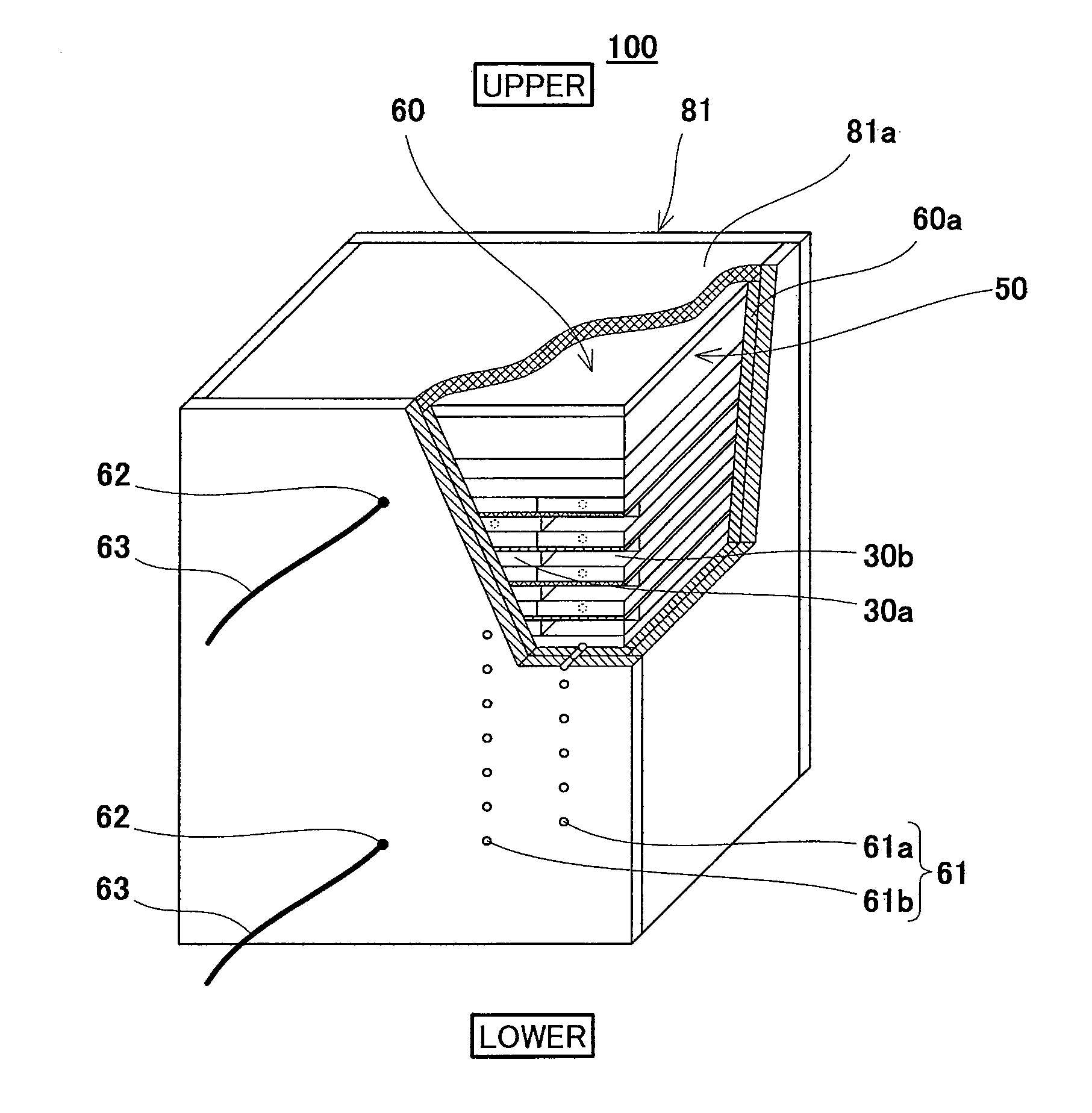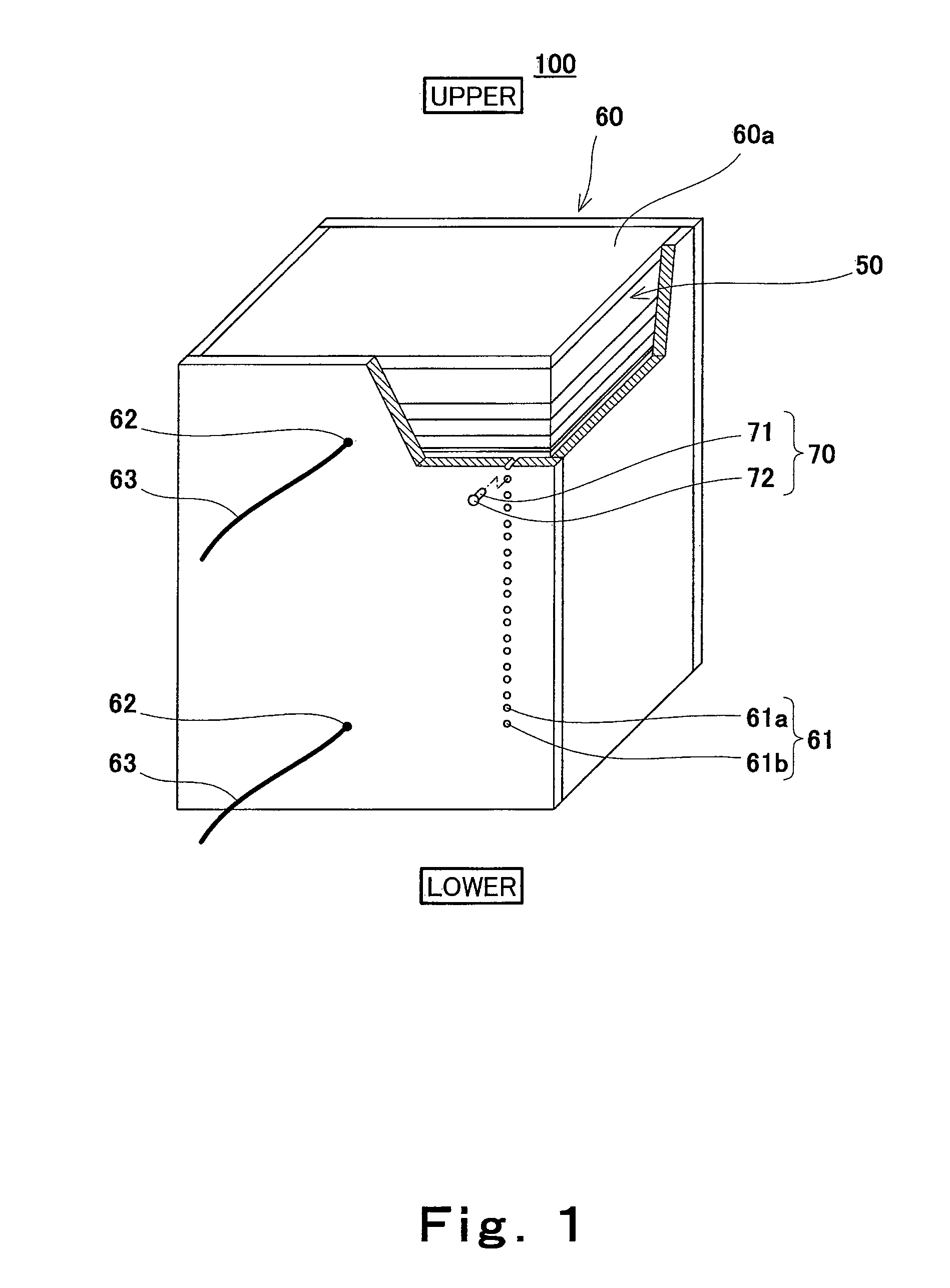Polymer electrolyte fuel cell and method for measuring voltages of cells in polymer electrolyte fuel cell
a technology of polymer electrolyte and fuel cell, which is applied in the direction of cell components, instruments, material electrochemical variables, etc., can solve the problems of difficult to simply and surely measure the voltage of each cell, and large number of operation steps, so as to prevent heat release via the voltage measuring terminal and ensure maintenance
- Summary
- Abstract
- Description
- Claims
- Application Information
AI Technical Summary
Benefits of technology
Problems solved by technology
Method used
Image
Examples
embodiment 1
[0128]FIG. 1 is a perspective view schematically showing a schematic configuration of a polymer electrolyte fuel cell according to Embodiment 1 of the present invention. In FIG. 1, a part of the polymer electrolyte fuel cell is cut away to show an internal structure thereof, and a vertical direction of the polymer electrolyte fuel cell is shown as a vertical direction of the drawing.
[0129]As shown in FIG. 1, a polymer electrolyte fuel cell (hereinafter referred to as “PEFC”) 100 according to Embodiment 1 includes a cell stack 50, a heat insulating casing 60, and stopper members 70.
[0130]First, the cell stack 50 will be explained in reference to FIG. 2.
[0131]FIG. 2 is a developed view schematically showing the cell stack 50 and cells constituting the cell stack 50 in the PEFC 100 shown in FIG. 1. In FIG. 2, a part of the cell stack 50 is omitted, and a vertical direction of the cell stack 50 is shown as a vertical direction of the drawing.
[0132]As shown in FIG. 2, the cell stack 50 i...
modification example 1
[0155]FIG. 3 is a perspective view schematically showing a schematic configuration of Modification Example 1 of the PEFC 100 according to Embodiment 1. In FIG. 3, a vertical direction of the PEFC 100 is shown as a vertical direction of the drawing.
[0156]As shown in FIG. 3, the voltage measuring terminal insertion hole 61 of the PEFC 100 of Modification Example 1 is constituted by a voltage measuring terminal insertion hole 61c and a voltage measuring terminal insertion hole 61d. The voltage measuring terminal insertion hole 61c is a through hole formed on the heat insulating plate 60a and has a circular cross-sectional shape. The voltage measuring terminal insertion hole 61d is a through hole formed on the heat insulating plate 60a and has a diamond cross-sectional shape. A pair of the voltage measuring terminal insertion holes 61c and 61d are arranged in the stack direction of the cells 10 in the cell stack body 51, and are formed at positions respectively corresponding to the anod...
modification example 2
[0159]FIG. 4 is a perspective view schematically showing a schematic configuration of Modification Example 2 of the PEFC 100 according to Embodiment 1. In FIG. 4, a vertical direction of the PEFC 100 is shown as a vertical direction of the drawing.
[0160]As shown in FIG. 4, in the PEFC 100 according to Modification Example 2, the voltage measuring terminal insertion hole 61 is constituted by voltage measuring terminal insertion holes 61e and 61f which are different from each other in size (cross-sectional area). With this, it is possible to prevent the voltage measuring terminal from being mistakenly inserted into the incorrect hole when carrying out the maintenance (when measuring the voltage of each cell 10).
[0161]Moreover, the size of the cross-sectional shape of the main body portion 71 of the stopper member 70 (not shown in FIG. 4) corresponds to the size of the opening of the voltage measuring terminal insertion hole 61e or 61f. With this, the heat release from each voltage mea...
PUM
| Property | Measurement | Unit |
|---|---|---|
| electrically-conductive | aaaaa | aaaaa |
| voltage | aaaaa | aaaaa |
| voltages | aaaaa | aaaaa |
Abstract
Description
Claims
Application Information
 Login to View More
Login to View More - R&D
- Intellectual Property
- Life Sciences
- Materials
- Tech Scout
- Unparalleled Data Quality
- Higher Quality Content
- 60% Fewer Hallucinations
Browse by: Latest US Patents, China's latest patents, Technical Efficacy Thesaurus, Application Domain, Technology Topic, Popular Technical Reports.
© 2025 PatSnap. All rights reserved.Legal|Privacy policy|Modern Slavery Act Transparency Statement|Sitemap|About US| Contact US: help@patsnap.com



